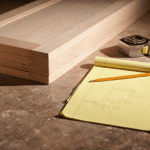
Imagine you’re walking through a forest and you see a tree bending gracefully with the wind. Now, imagine if you could create something just as beautiful with wood! That’s the magic of wood bending. It’s like having a superpower to shape wood into curves and loops, making it dance to your design. This blog post will take you on a fantastic journey into the world of wood bending, a technique that turns straight, stiff wood into amazing curved pieces. Whether you’re a curious student or an aspiring woodworker, get ready to explore the art of bending wood!
The Basics of Wood Bending
Wood bending is a skilled craft where wood is softened to mold it into various curves, much like how clay is shaped when pliable. However, unlike clay, wood isn’t naturally flexible and requires assistance to bend. This is where specialized bending techniques play a crucial role. These methods transform rigid wood into elegant, curved shapes, offering a blend of artistic creativity and technical prowess. Understanding these techniques is essential to mastering the art of wood bending and achieving desired shapes and designs in woodworking.
Steam Bending
Steam bending is a remarkable technique akin to placing wood in a sauna. In this process, wood is subjected to hot steam in a steam box, softening it significantly. Once steamed, the wood gains a flexibility similar to that of a cooked spaghetti noodle, making it malleable. It is then swiftly shaped over a specific form to achieve the desired curve. After shaping, the wood is left to dry, solidifying in its new form. This method effectively produces beautifully curved wood pieces, showcasing the transformative power of steam.

Kerf Cutting
Kerf cutting in woodworking is akin to giving wood a series of small cuts, much like a haircut, to enhance its flexibility. This technique involves making multiple, evenly spaced cuts along the wood, creating a series of ‘joints’ that enable it to bend smoothly. This process is similar to the flexibility of a bendy straw, allowing the wood to curve and bend with ease, perfect for creating unique shapes and angles in woodworking projects.
Lamination
Lamination in woodworking resembles sandwich-making, where thin wood strips are layered and glued over a mold. As the glue sets, these layers fuse, maintaining the desired curved shape. This robust method excels in crafting intricate curves, leveraging the strength of combined layers for stability and aesthetic appeal. It’s a go-to technique for complex designs requiring durability and precision in curvature.
Tools and Safety
When engaging in woodworking, prioritizing safety is crucial. It’s essential to always wear protective gear like safety glasses and gloves. Careful handling of tools, including saws and clamps, is imperative to avoid accidents. Safety isn’t just a precaution; it’s a smart approach to any woodworking project. Remember, being cautious and prepared ensures a safer and more enjoyable crafting experience.

Crafting Your Own Curved Wood Piece
Ready to try bending wood? Here’s a simple project to start with. Let’s make a curved picture frame!
- Choose Your Wood: Start with a softwood like pine, which is easier to bend.
- Steam Bending: Build a small steam box and steam your wood for about an hour.
- Shaping: While the wood is still hot and flexible, bend it around a circular form, like a big can.
- Drying: Secure the wood with clamps and let it dry for a day.
- Finishing: Once dry, remove the wood and sand it smooth. Add a finish like varnish, and you have a beautiful curved picture frame!
Conclusion
The art of bending wood is a fantastic journey from rigid to remarkable. It’s not just about making curved wood pieces; it’s about transforming imagination into reality. Whether you’re creating a simple curved frame or dreaming up a fancy piece of furniture, wood bending is a skill that opens a world of creativity. So, grab some wood, and let’s bend the rules of what’s possible! Remember, every great craftsman was once a beginner. Your journey in wood bending starts with a single curve. Let’s shape the future, one bend at a time!






